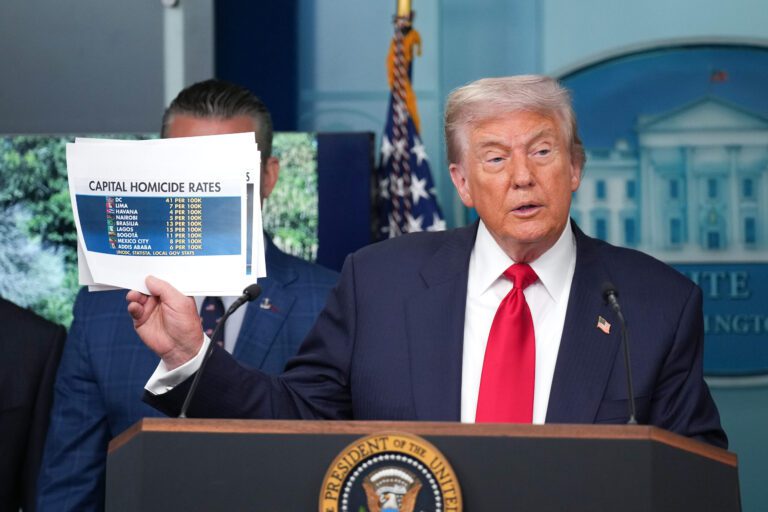President Trump Declares "Liberation Day" in Washington, D.C. Amid Crime Surge
In a transformative press briefing at the White House, President Donald Trump characterized Monday as "Liberation Day" for Washington, D.C., marking a pivotal shift in the federal government’s approach to combating escalating crime in the capital. Flanked by prominent members of his administration—Attorney General Pam Bondi and U.S. Attorney for D.C., Jeanine Pirro—Trump outlined ambitious plans aimed at restoring law and order.
“This is Liberation Day in DC and we’re gonna take our capital back,” President Trump declared, underscoring the urgency of his initiative.
Federal Control Over D.C. Police
To tackle the increasing crime rates, President Trump invoked Section 740 of the District of Columbia Home Rule Act, formally placing the D.C. Metropolitan Police Department under federal control. This decision enables the administration to deploy resources more effectively in the nation’s capital, highlighting serious concerns about public safety.
His announcement was supported by two key executive orders:
- Executive Order 1: Invoked presidential powers to assume control of the D.C. Metropolitan Police Department.
- Executive Order 2: Directed Secretary of Defense Pete Hegseth to mobilize National Guard troops throughout Washington, D.C.
“We will work alongside all D.C. police and federal law enforcement,” stated Hegseth, assuring that National Guard troops would be "flowing into the streets of Washington in the coming week."
Deployment Details:
- 800 D.C. National Guard troops will be stationed across the city, alongside specialized military units as needed.
Crime Statistics and Comparisons
In his remarks, President Trump drew alarming comparisons, claiming that the murder rate in Washington, D.C., surpasses that of notorious cities like Bogotá and Mexico City.
“The murder rate in Washington today is higher than that of Bogotá, Colombia, and Mexico City… You want to be able to leave your apartment or house and feel safe, and you don’t have that now,” Trump asserted.
Despite Trump’s alarming statements, recent data from the Department of Justice indicates:
- A 30-year low in violent crime in Washington D.C. as of 2024.
- Homicides have decreased by more than 10% compared to the previous year.
- Sex abuse crimes are down by nearly 50%.
- Robberies have decreased by almost 30%.
Opposing Views
Mayor Muriel Bowser challenged Trump’s narrative, describing comparisons to war-torn nations as "hyperbolic and false."
“If the priority is to show force in an American city, we know he can do that here. But it won’t be because there’s a spike in crime,” she stated during an MSNBC interview.
According to Zach Smith, a former federal prosecutor and current legal fellow at the Heritage Foundation, there are concerns regarding the reliability of crime data:
- Changes in how the FBI collects and reports crime data could lead to disparities.
- Many incidents of violent crime go unreported, as victims may believe law enforcement will not take action.
“How many people would be willing to let their loved ones walk down the street in D.C. at night?” Smith questioned, indicating a hesitation among residents regarding safety.
Future Implications
President Trump hinted that similar measures could be adopted in other major cities facing violent crime issues, including Chicago and Los Angeles.
“We’re not gonna lose our cities over this. This will go further,” he warned while emphasizing the urgency of addressing crime in the capital.
Conclusion
President Trump’s declaration of "Liberation Day" signifies a substantial federal response to crime in Washington, D.C. With the invocation of presidential powers and a significant deployment of National Guard troops, the administration aims to reassure citizens that safety and order will be swiftly restored. Understanding the complexities of crime statistics and the varying perspectives on public safety will be crucial as these developments unfold.
For more insights about urban safety and crime trends across the United States, visit Bureau of Justice Statistics and FBI Crime Data.


